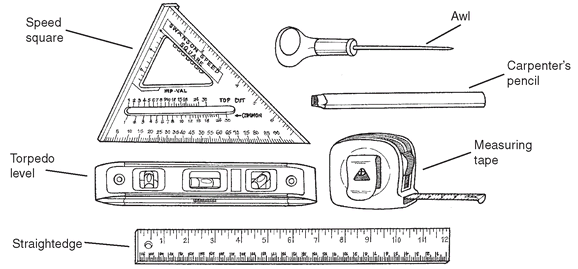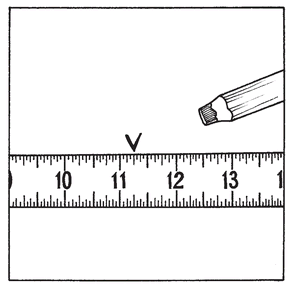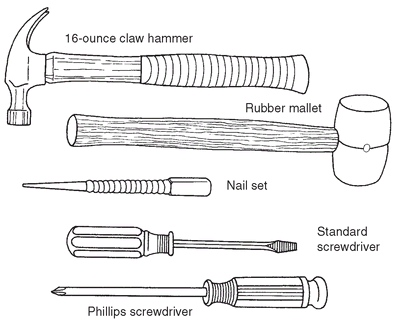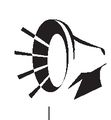Chapter 1
Your Personal Tool Kit
In This Chapter
• When it comes to tools, quality counts
• The basic categories of tools
• Must-have tools in your starter set
• The one power tool you’ll need for repairs
• How to choose the right tools for you
I’ve never tried it, but I could probably knit a sweater using two pencils, and coax a nail out of the wall with the tip of a metal ruler. But pencils weren’t designed for knitting, and the ruler isn’t really a nail-pulling tool. Having the right equipment for a task usually makes the work easier, quicker, and safer.
Home repair and improvement can be broken down into a handful of actions: measuring and marking, cutting, fastening and joining, taking apart (also known as demolition), and applying. A few tools can do more than one thing, but this way of sorting them will help you remember what their primary use is.
If you can, hold a new tool in your hand before you buy it; it should be a comfortable fit, like a good pair of shoes!
Quality Counts
You can buy a cheap set of tools, and they’ll probably work fine, at least for a while. Expect to replace the bargains after a couple of years. Often made of lesser-grade metals and plastic, the tips, teeth, and edges of inexpensive tools will show wear sooner, rather than later. When it comes to tools, quality counts … and costs. Most of the well-known brand name manufacturers produce tools at differing quality levels, with professional grade being the best and most expensive of the lot. Good tools will probably last a lifetime, and you can leave best-quality equipment to your grandchildren!
Sets of multiple sizes of screwdrivers, wrenches, and the like will be cheaper than buying each item singly. However, unless you’re planning to repair your whole house yourself, unassisted by friends or hired hands who have their own tools, don’t go overboard. Buy the best equipment you can afford and, except for the most basic tools, buy them as you need them.
If cash is tight, and you’re really good about returning things you borrow, neighbors and friends might loan you their equipment. Take good care of borrowed tools, and return them promptly. Most folks I know are very possessive of their toolbox, and want things returned in the same condition as when they were loaned. If your borrowing etiquette is poor, most lenders won’t give you a second chance!
Measure Up: Rule(r)s of the Road
A sturdy 20- or 25-foot retractable measuring tape is indispensable for all kinds of jobs around the house. Some people opt for the lighter-weight, 12-foot model, but eventually realize that the longer one is more versatile.
These come in plastic or metal cases, and the best have a stop lever so that you can extend and hold the tape in its extended position, without holding on to the case. This is a particularly good feature when you’re marking the distance of long runs around a room.
About those little tick marks along the tape: carpenters can tell at a glance whether a mark indicates 7⅜ inches or 7⅝. If you’re not so good at fractions, get a tape with a fractional read. This measure has the intervals—eighths, quarters, and halves of inches—marked clearly with the appropriate fraction, so you don’t need to guess.
Better-quality tapes also have a clasp that makes it easy to attach the case to your belt while working, so you don’t have to constantly hunt for it.
A metal ruler—also known as a straightedge—is another handy device for measuring. It serves as a ruler and as a rigid guide for a utility knife or glass cutter when you want to score a surface. An 18” straightedge is a good size for lots of jobs. Straightedges are also available in plastic; metal is slightly more expensive but much more durable.
A speed square has a lot of uses in carpentry, allowing you to mark angles, then draw guidelines. One of the straight sides of this triangular device has a lip, which can fit along the edge of a piece of material (a 2×4 piece of framing lumber, for example) letting its other straight side serve as a guide for marking/cutting a piece of wood or other material at a perfectly perpendicular angle (90 degrees). Speed squares are made in metal and plastic; I like the heft and feel of the metal variety.
Unless you’re planning to do lots of carpentry, you don’t need a big, fancy, and expensive carpenter’s level. Instead, opt for a small torpedo level, so called because of its shape, to check whether shelves, rods, curtain poles, doors, and other household objects are hanging straight horizontally (level) or vertically (plumb). The torpedo level is one type of spirit level, so called because the measuring device employs a vial filled with liquid, usually ethanol—the “spirit”—containing an air bubble that falls between guidelines when the instrument rests plumb or level.

Measuring and marking tools.

Ounce of Prevention
Though its name sounds like a guided weapon, a torpedo level is easily damaged. If you drop it, it may no longer read true. So handle it with care!
Make Your Mark
An awl is a tool with a handle attached to a slim metal shaft with a pointed tip; it looks like a miniature ice pick. It can punch a hole in a piece of leather or a strip of wood, but for our purposes, it’s a great way to scratch-mark the location for a new screw or nail on a wall or other surface.
An awl is one of those tools you can pick up for a quarter at a tag sale. Some older models have nice wooden handles. Just make sure that the shaft is firmly attached to the handle, or the tool is useless.
If you like to stash your pencil behind your ear, any sharpened #2 pencil is a good marker for your measurements and guidelines. A lot of pros think the garden-variety yellow pencil is just fine, too, but some like the carpenter’s pencil, which can be sharpened with a utility knife and won’t roll away. It looks like a regular pencil flattened by a steamroller! One disadvantage is that the carpenter model does not have an eraser attached; carpenters may not need erasers when they make marks, but sometimes new-bie DIY-ers (do-it-yourselfers) do!
Sometimes using a pencil line as the guide for installing a fastener or making a cut leaves a mark that’s wiggly, and leaves you scratching your head about the right location. Or, you used a dull pencil and the line is too thick to be precise. Instead, mark the right spot with a V. Put the point of the V at the spot you measured (see next figure). Then your nail or cut will be true to your intentions.
There’s an old saying—a carpenter’s old saw, to be precise—that goes, “Measure twice, cut once.” This alludes to the importance of making good measurements, then checking them before you pick up your other tools.
When I first learned to use a circular saw, I measured twice, then turned on this most awe-inspiring power tool and made my cut. The cut was perfect, but my measurement was not; my piece was off by a quarter inch! I had to put my beautiful 2×4 in the “use later” pile for another part of the cabin I was working on.
Scrap you don’t use becomes expensive trash. Until I mastered measuring, I always measured three times, or until I got the same measurement twice in a row. DIY 101-ers, take heed!

V-mark measurement.
The Cutting Edge: Sharp Helpers
You need just a few sharp tools for most of the cutting you’ll do for basic improvements and repairs.
I don’t know about your house, but in mine, scissors tend to migrate, like all those socks that disappear in the dryer, never to be seen again. To remind yourself to return them to your toolbox when you’ve “borrowed” them for another purpose, take a piece of masking tape and label your toolbox scissors (“Mom’s toolbox,” or “Dad’s toolbox,” or “My toolbox”) so they aren’t MIA when you need them. Sturdy scissors with 5” blades should handle most cutting tasks nicely.
There are so many uses for a utility knife around the house that a list of them could practically fill this book. Although you can pick up a plastic, pencil-sized, 99-cent model at most hardware checkout counters, invest in the standard, palm-filling metal model. It fits comfortably in your hand, and you can adjust and retract the blade with a simple lever. Plus, it uses disposable blades that can be stored inside the handle. It costs a couple of bucks and will last a lifetime.

Ounce of Prevention
The blade of a utility knife is very sharp. Always keep the business end retracted when you’re not using the knife.
Wire cutters do what they say. In a pinch, you can repeatedly twist a wire until it breaks from all the abuse, but a wire cutter does the job in a single snip!
When you’re learning repair and DIY skills, the most versatile hand saw for cutting wood is called, simply, a toolbox saw; it has a fairly short blade (about 15 inches or so), and is easy to use. Look for a model that can be re-sharpened, as all saws will lose their edge over time. The toolbox saw is good for making short cuts; remember only to apply pressure on your downstroke (push).
Although it may look scary, it works great. I’d never seen a Japanese pull saw before I took a course in carpentry for women a few years ago. The one pictured is a double-edged saw; one side has coarse rip teeth for cutting wood with the grain, and the other side has more closely spaced cross-cut teeth, for (did you guess?) cutting across the grain. It looks like a most imposing spatula, and unlike the American toolbox saw, it cuts on the pull stroke—a much easier and more elegant way to saw, to my way of thinking. And when the saw gets dull, you can buy a replacement blade.
Cutting tools.


What Pros Know
The first time I used a toolbox saw, I started hacking away, using pressure while I pushed down and pressure when I pulled back. Being a more sensitive creature than you’d think, the saw bucked and whined, and later, my husband accused me of dulling the blade. He was right! Saws cut one way; most American saws will cut on the push—the downstroke; Japanese saws will cut on the pull movement. I never noticed this little wrinkle when I was growing up, watching my Dad do stuff around the house. But now I know. If you get a chance to try before you buy, you can decide which type of saw you prefer.
Putting It Together: Tools for Fastening and Joining
Nail meets wall, screw meets joist. Putting things together is a major part of home repair and improvement. Having a good selection of tools to make this togetherness happen is an important facet of homeownership. Because, as you will discover, things meant to be together will sometimes fall apart!

Fastening/joining tools.
Basic Tools
A hammer is such a basic piece of equipment that it should be anyone’s going-away present when leaving the comfort of Mom and Dad’s house, where things so magically stayed together. A 16-ounce claw hammer, with a curved claw for pulling out nailing mistakes, is a good basic size and style. You can tell the difference between this one and the larger framing hammer (for putting up walls and other work requiring nailing above one’s head, or at funny angles), because the framing hammer has a longer handle.
There is usually such an array of hammers at the home center or hardware store that you may have trouble choosing. Pick what feels good in your hand. Don’t choke up on the hammer handle, but use the handle as an extension of your arm. If the 16-ounce model feels too heavy, drop down to a 12-ounce. But don’t go for a cheap, wimpy, 7-ounce hammer (these are sometimes part of an equally cheap set of fastening/joining tools). This mini is good for tacks but not much else.
Sometimes you need to drive in a nail but don’t want to damage the surrounding area, so the metal head of your claw hammer won’t do. An inexpensive rubber mallet gets the job done.
Another tool that lets you drive a nail below a surface (called countersinking) while leaving the surrounding area undisturbed is a nail set. Often sold in sets of three or more standard sizes to match different nail heads, you can position the nail set over the nail head to drive your nail smoothly “underground.”
A good selection of screwdrivers belongs in every tool kit. Composed of a shank with a flat tip that looks like a minus sign (-), called a standard screwdriver, or a tip that looks like a plus sign (+) called a Phillips screwdriver, with a handle of wood, metal, or some type of hardened plastic, screwdrivers are available in a number of point sizes. Shanks also come in a number of different lengths: long shanks let you reach into tight spaces; short, stubby shanks give you more turning power.

What Pros Know
Always use the right size driver for the fastener you are driving. Use the Phillips screwdriver for Phillips head screws (more prevalent than single-slot screws today). Use the standard driver for slotted screws. Too-big or too-small driver points can damage or deform the fastener. And don’t forget this helpful saying: “Righty, tighty; lefty, loosey.” Translation: tighten by turning to the right (clockwise); loosen by turning to the left (counterclockwise). It works for screws, nuts, light bulbs. Any threaded object turns on the same principle.
Specialized Tools
A good hammer and half a dozen screwdrivers will suffice for probably 75 percent of the joining and fastening tasks in your home. But other fastening tools, for grasping and turning specialized fasteners, and holding the work while you do the job, are great to have on hand.

Wrenches, pliers, and clamps.
Nuts, big bolts, pipes, hard-to-reach wires—sooner or later, you’ll have a job that requires more specialized gear to help you grab hold of an irregularly sized piece of something, keep it steady, turn it, move it, or attach it to something else.
Sometimes, door latches, light fixtures, or other house hardware is joined with fasteners that require a hexagonal tool, called an Allen (or hex) wrench to attach or detach a part. Allen wrenches are sold in sets, sometimes conveniently encased in a penknifelike sheath. This is a good way to buy them, since the wrenches are comparatively small and easy to lose. Simply extend the right size wrench, leaving the others tucked away in the sheath.
An adjustable wrench is a great way to get hold of a nut so that you can loosen and remove it from its bolt. The jaws of the wrench hold tight to the nut with a few turns of the little adjusting gear. While you can buy a set of wrenches that fit perfectly around each size nut, often the size you need will be missing from the set. (This has happened to me more than once at crucial moments such as—gulp!—Christmas Eve, with something complicated that needs assembly.) An adjustable model is inexpensive and versatile.
If you’re all thumbs, needlenose pliers are perfect for “grab and twist” workouts with wires of all types—phone, electrical, audio. They look just like their name sounds. If you’re working with electric wires, choose a model with insulated handles, one of the many safeguards against shocks you’ll learn about as you read this book.
Locking pliers are another handy tool; the most famous variety is the Vise-Grip brand, invented by a smart Danish-American from Nebraska named William Peterson. He wanted a tool that worked like pliers and could grip metal parts in his blacksmith shop “like a vise.” They still do, and several manufacturers have variations on this tool, which has a lever that locks the jaws of the pliers in place. They work like a third hand for many jobs.

Ounce of Prevention
If you want to protect the surfaces you’re clamping together, insert little pieces of wood or cardboard, also known as shims, between the clamp jaws and the work piece, so the clamps don’t leave a mark.
When you have to glue things together and hold them tightly in place until the adhesive dries, C-clamps will do the job. There are a variety of other, more expensive clamping devices, and you can explore the shelves of the hardware or woodworking shop when the time comes to expand your collection.
Demolition Derby: Tools That Take Things Apart
The pros call it “demo,” and they usually enjoy this part of home improvement: you see the results of your work nearly instantly. Some of you may think this sounds like your kind of fun. But before you start tearing up that 70s shag carpet in the den, remember that you’ll have to figure out what to do with what lies beneath the fuzzy, matted mess. And it might not be pretty. So before you tear anything apart, think: can I live with the result for a while?
Sometimes you get lucky. In one room of our family’s Maine house, armed with utility knives and small pry bars to remove the furring strips, my niece and I tore out an old, worn red carpet that was driving me crazy. It was a messy job, but we found a wax-and-buff-ready maple floor beneath.
We were not so lucky in the kitchen. Beneath the multicolor indoor/outdoor carpet was a glued-down layer of carpet padding. Beneath that was a layer of brown linoleum with yellow, red, and green spots. And beneath that was a layer of fifty-year-old gooey black adhesive. Having made this discovery in an inconspicuous corner of the kitchen, I knew my limits, and called in the pros. But it was several months before they could schedule the work and reveal the golden planks of the original maple floor.
So be careful about using your demolition tools!
Pry bars come in many different sizes; keep one that’s about 8”-10” long in your tool kit. It can neatly squeeze under old tile, flooring, or carpet furring strips, and its lever action plus your muscles make quick work of many demo jobs. (One company even calls its model the “Wonder Bar,” a great name for this handy tool.)
I’ve always been a cat person, but never heard of the handy cat’s paw until I went to carpentry class. Like its larger cousin the crowbar, this sturdy tool is a fairly heavy (for its size) round or hexagonal bar of steel. It curves at one end to form a cup-shaped tip with a V-slot that can grip around a nail head. Hammer just above the back of the V-slotted tip, working the slot around the nail head. When the nail head is seated in the slot, rock back the cat’s paw and the nail glides out (finish it off with your hammer claw). It’s a beautiful piece of equipment for removing nails when you don’t care how the surrounding wood looks afterwards (you can lessen the damage by sliding a shim under the “heel” of the V-slotted paw as you work out the nail). You may not need this tool right away, but when you get to taking out old work with lots of nails, this will come in handy.
A cold chisel is another one of those old tools that show up at tag sales on the cheap. It gets its name from the fact that this tempered steel cutter is used for cutting “cold” metals, and not used in conjunction with heat, as in torches or forges. Paired with a hammer to drive its point, it’s a good tool for removing cemented tile. Just remember that when you’re cutting into hard materials, these can chip and fly. Always wear safety goggles and other protective gear; see Chapter 2 for the particulars.
Demolition tools.

The One Tool You Can’t Live Without
For the repairs in this book, you’ll need just one basic power tool: an electric drill. Corded models have been around for years, but battery-powered drills are so improved that they are worth more than a second look. You won’t have to plug into a socket with the cordless variety, so it’s much more versatile. For optimum use time, buy one with a charger and two batteries (one to use, one spare to keep charged when you’re doing a lot of drilling and don’t want to lose power at a crucial moment).

What Pros Know
Don’t forget the feel-good factor! Get a drill with the features you want, but also make sure it feels comfortable in your hands and doesn’t weigh you down. If it doesn’t feel right, you’ve wasted your good money.
A visit to the power tool department of your hardware or home center can be a heady experience: so many drills, lots of different prices. When considering which to buy, think about what you need.

Cordless electric drill.
Power
Most DIY (not pro-grade) corded models quote power in the range of 500 to 1,000 watts. The higher-wattage models will have sturdier parts and be able to take more abuse.
Same with cordless; 9.6-volt batteries don’t pack the power of a 12V- or 18V-powered cordless drill. If you are going to use the drill a lot, or want it to last, opt for the most power you can handle (the higher voltage battery packs and sturdier parts increase the weight of the tool).
There are different types of batteries for cordless drills; the most common are Nickel Metal Hydride (Ni-Mh) and Nickel Cadmium (Ni-Cd, or “ni-cad”).
Speed
Single-speed drills lack versatility. If you’re using large bits for big holes, the bit needs to turn more slowly or you’ll wear out the bit quickly. A step-up option is a drill with two fixed speeds—there’s usually a manual switch that makes this adjustment.
A variable speed control offers an infinite number of speeds up to an indicated (read the package) limit. You control the speed by a trigger, and some drills have adjustable trigger stops so you don’t accidentally put the tool in overdrive when high speed is not needed.
Keyless Chuck
In the old days, bits were inserted into the business end of the drill by opening and closing the chuck (which holds the shaft of the bit) with a key. After a bunch of years, manufacturers realized that people always lost the key, so drills with a keyless chuck are pretty standard these days. Lots of pros love them; my dad had one, but I haven’t seen a keyed chuck drill in years! ⅜” the most common chuck size, and right for the work in this book.
Screwdriving
For your drill to work like a screwdriver, it needs three attributes: variable speed, a reverse drive, and a torque control that shuts off the drill when a certain turning force is reached. You know the drill has this last feature if there’s a numbered dial (up to 16 positions). Torque control prevents you from driving the screw too deeply or too tightly.
Helpful Bits About Drilling

What Pros Know
If you’re driving a bunch of screws, find the right turning force for the job by testing your setting and screw on a scrap piece (wood or drywall). Oh, and one more thing: to use the drill like a screwdriver you’ll need screwdriver bits!
If you’ve never used an electric drill before, know that it’s destined to make many home repairs simpler than you can imagine. Here are a few tips for using it safely and well:
• Always wear safety goggles when you drill. That stuff you’re drilling has to go somewhere, and you don’t want that somewhere to be your eyes.
• Use the highest speeds for jobs that use the small bits, and slower speeds for big bits.
• Indent your drill-in point with a nail or the tip of a nail or screw. This will prevent the drill from sliding off the mark.
• Leave the motor running when you’re removing the bit from your work. If the drill ever gets stuck in the work, turn off the drill and then restart it in reverse.
Put It There! Applying the Right Stuff
Lots of repairs use patching compounds, adhesives, and other stuff best applied (or smoothed) with a tool. These are almost self-explanatory:
• Putty knives come in a variety of widths; they’re great for applying all kinds of goop for various repair chores. They’re also quite useful for scraping, lifting, and prying in certain circumstances. A narrow one (2”) and a broader one (4-6”) are a good basic pair to own. Better models have metal ends on the handles that will take the force of a hammer (when you’re trying to open a stuck window, for example) without breaking the handle.
• A 2” nylon-bristle paintbrush and a clean old toothbrush can be used to brush away dust or other particles, and also to apply various liquids.
• A household sponge is good for cleanups, but it’s also good as an applicator for certain liquids. Keep a clean one handy.

Applicators.
Hold It! Transporting Your Tools
Box, bag, or bucket? When you’re assembling tools to do a repair job, it’s good to have a container that holds everything you need. I like my canvas rigger’s bag. It holds a ton of tools, was inexpensive, and is incredibly sturdy. However, you can get a tool bucket, which is an ordinary bucket equipped with a canvas tool holder that makes an incredibly roomy tool caddy. Or opt for a conventional toolbox. Go for sturdy, go for capacity, and choose a container that has enough slots for those tools you want to keep handy, or those you want to protect from other tools banging against them.
Tool bag.

Tool belts are another personal choice. I like the simple canvas apron that costs a couple of dollars. It has a few sturdy pockets to held the fasteners I’m using and a small tool or two. I use the tool bag to carry the rest of the stuff. Too many tools around my waist weigh me down.
Some people opt for the heavy belt with leather or canvas pockets and a nice loop in which to slide the handle of your hammer. My husband bought me one of these when I went off to carpentry class. I use it sometimes, but the hammer kept hitting me in the thigh and gave me a bruise after a week of building. I did notice, however, that my carpentry teacher had a solution for this: she maneuvered the belt so the hammer hung over her backside, and whenever she needed it, she’d just reach back and pull it out. What’s that old saying? Each to his/her own!
I Can See Clearly Now
No set of tools is complete without a working flashlight. Because so much repair goes on in basements, attics, and other dimly-lit recesses of the house, buy one that fits in your tool bag, make sure it lights, and stick an extra set of batteries for it in the bag for good measure!

Flashlight.
Your Work Space
Most of the repairs in this book are done on-site, where the damage has occurred. But once in a while you’ll need to cut or saw something, and will need a flat, durable surface on which to place and maneuver your work.
If you’re reading this book, you probably don’t have a big, fancy workbench with a vise to hold things. The good news is: there are many fairly inexpensive substitutes for this handyman’s standby.
If you’re old enough to remember the film The Graduate, when actor Dustin Hoffman was a young man, there’s a memorable scene when an old guy gives our hero a word to live by: plastics.
def•i•ni•tion
A vise is a tool with two jaws, closed by a screw or a lever to hold objects immobile.
If you’ve got very little space to set up a workbench, a couple of companies now make very sturdy, hardened plastic, portable workbenches that fold into a couple of inches of space in a small closet, and give you a place to set and clamp your work. This is a worthy investment.
And if you’re a purist, a sheet of plywood clamped to a pair of sawhorses (you can buy a sturdy, folding, portable pair for less than forty bucks) will serve you well for most jobs, and also fits into a small space for storage.

Ounce of Prevention
Never work with a saw or other cutting device without clamping the work piece to the work surface. ‘Nuf said.
The key here is sturdy, stable, and clamp-able. A work surface should support your work and keep it steady, and you should be able to hold your work piece in place with a clamp.
When you graduate from DIY 101, you can move on up to one of those big hardwood workbenches that sell for a couple of hundred bucks at specialty woodworking shops. But you won’t need it right now.
The Least You Need to Know
• Cheap tools don’t last long; get the basics, but get the best you can afford.
• Tools can be categorized by their functions: measuring and marking, cutting, fastening and joining, demolition, and application.
• An electric drill should be your first power tool; look for features you’ll really use, and a model that feels good in your hands.
• You need a stable, sturdy surface for some DIY work where you can clamp a piece that needs cutting or sawing.
• There are portable options that are easy to store if your working space is limited.
..................Content has been hidden....................
You can't read the all page of ebook, please click here login for view all page.
